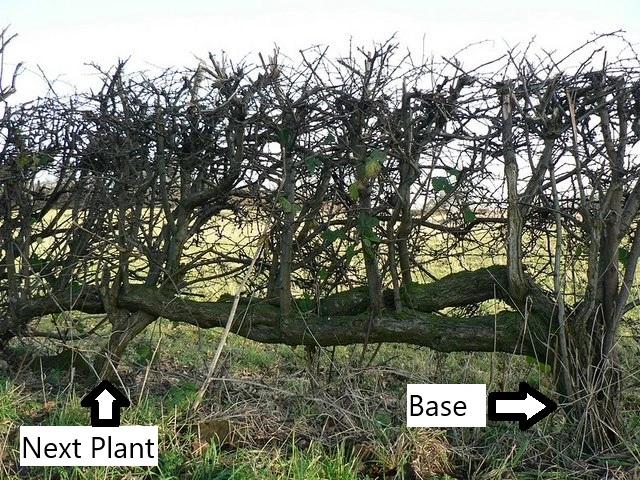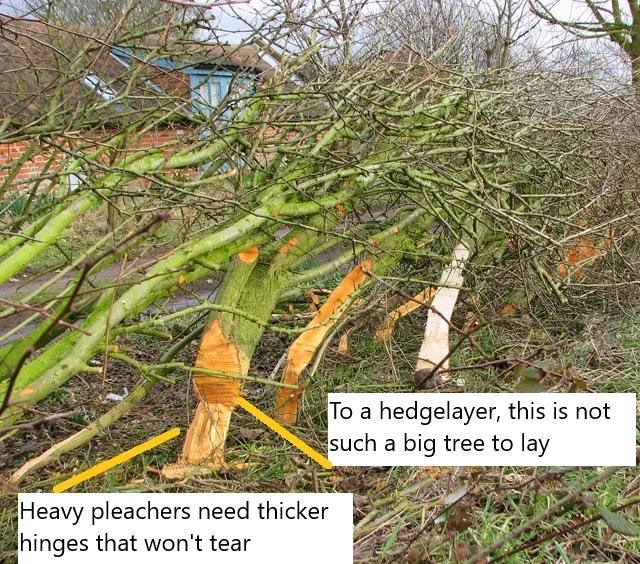Table of Contents
Hedgelaying Services & Grants
- To hire a hedgelayer to work on your hedge, use the National Hedgelaying Society’s map.
- To find a hedge laying course or event near you, use the National Hedgelaying Society’s course list.
- Apply for the BN5 Hedgelaying grant, which is for native hedges over 20m long. It’s usually claimed for country hedges, but several classic garden hedge plants are native and lay well, such as Yew, Hornbeam, or Beech.
What is Hedgelaying?
For those who don’t know, asking a farmer is a sensible place to start:
Hedge laying is the art of rejuvenating a hedge to keep it solid and stockproof.
- The hedge plants’ naturally vertical stems (henceforth pleachers) are cut part way through at the base so they can bend and lay down at an angle while still completely alive.
- The pleachers are woven around support stakes, then bound together with horizontal binders of cut branches, ideally flexible hazel or willow.
- Each hedge plant grows back densely from the base, the same as it would when coppiced, as well as all along the pleachers.
- By making vertical stems lay down, you keep as much wood as possible.
- It looks bare at first, but within one growing season it will need trimming to keep lanky stems in shape!
How to Lay an English Country Hedge
The National Hedgelaying Society has records of over 30 hedgelaying styles, the eleven most common ones are described here.
- Country hedges are typically laid as needed, a rule of thumb for reasonably well maintained hedges is every fifty years. It’s common to lay a country hedge for the first time when it’s about 15 years old because the work is easy at that age, and should delay the need for future laying well past the lifetimes of the adults involved.
- Garden hedges are not commonly laid, but most hedge plant species are suitable, apart from conifers (excluding Yew), and plants with brittle wood like Holly or Laurels.
For wildlife, laying hedges is great long term, however, a freshly laid hedge offers reduced habitat space.
Therefore, your nesting birds will thank you for laying sections of your hedge each year, rather than trying to get it all done at once.
“Lay Uphill, Work Downhill” Hedge Laying Rule
- On a slope, even a very shallow one, you lay the pleachers pointing uphill.
- This means you start at the top of the hill and work travelling downhill.
- It’s impossible to start laying at the bottom and work uphill.
Will laying a hedge save me from buying new hedge plants to fill gaps?
Yes, in most cases. Hedgelaying can cover quite wide gaps, but it can’t work miracles, and sometimes one ideally should put in replacement plants.
Still, things aren’t always ideal, and it’s amazing what value you can get from one pleacher!

Image Copyright Rich Tea
How big of a trunk can you lay?
If the wood is flexible enough, you can lay trees as big as you can safely lower to the ground without dropping them.

Image Copyright Evelyn Simak
In this Somerset Hedgelayers video, note that the big tree being laid had been pollarded the year before, as you can see from the twiggy regrowth at the top.
That staggered approach has to be best for the tree’s recovery, but it should be fine to pollard and lay any native tree in the same year.
He efficiently uses the pleacher’s own weight to help pull it down against the strength of the hinge at the base, which needs to be strong enough not to tear.
The brush of branches at the top becomes a support against the ground to hold the laid trunk above horizontal.
Further Research
Critiquing a Real Farm Hedgelaying Example
The critical comments on this hedge laying in 4 easy steps video are instructive; in our view, they are comparing a perfect world scenario to a “getting stuff done at work” scenario.
Jamie Temple commented, “Centuries of hedgelayers crying at this video. Hate being negative online but this is 100% how not to do it.”
To which we reply:
- I think Jamie is getting at the hedge being prepped using a tractor mounted flail, which is how most farm hedges are managed now. It’s not elegant, but it turns days of manual labour into a few hours of flailing and chipping.
- Topping the hedge to 2.4 metres is shorter than necessary, longer pleachers are better for the strength of the newly laid hedge, but 2.4m is fine to work with (it might be the maximum reach of the flail from the road).
- The laying work itself is completely fine: the binders on the top are rough’n’ready, they won’t be winning any competition awards, but they do the job.
- Look closely at the base of the hedge at the end, it seems that some large pleachers might fail because they aren’t supported up off the ground. But if you don’t try you’ll never know, and if they fail it’s no harm, there are plenty of strong pleachers.
Master Hedgelayer Paul A Lamb
His hedgelaying memoir is out in 2025, make yourself a tea and check out his insta reels.
